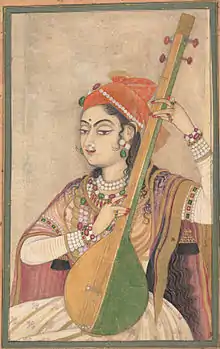Music of Sikkim
Music of Sikkim ranges from traditional Nepali folk music to Westernized pop music. The ethnic communities, Lepcha, Limbu, Bhutia and Nepalis constitute the music which is an ingrained part of Sikkimese culture.
| Music of India | |
|---|---|
 A lady playing the Tanpura, c. 1735 (Rajasthan) | |
| Genres | |
Traditional
Modern | |
| Media and performance | |
| Music awards | |
| Music festivals | |
| Music media | |
| Nationalistic and patriotic songs | |
| National anthem | Jana Gana Mana |
| Regional music | |
| |
The main traditional style is the Nepali folk music known as Tamang Selo, This music of the Tamang community is performed to the rhythmic sound of “Dhamphu”, a musical instrument. Western-style pop is popular in the region, as well as western-style foreign music styles.

Tamang Selo
This is a musical genre of the Tamang people and popular amongst the Nepali speaking community in West Bengal, Sikkim, India and around the world. It is accompanied by Tamang instruments, the Madal, Damphu and Tungna, although nowadays musicians have taken to modern instruments. A Tamang Selo can be catchy and lively or slow and melodious and is usually sung to convey sorrow, love, happiness or day-to-day incidents and stories of folklore.[1]
Hira Devi Waiba is hailed as the pioneer of Nepali folk songs and Tamang Selo. Her song 'Chura ta Hoina Astura' (चुरा त होइन अस्तुरा) is said to be the first Tamang Selo ever recorded. She has sung nearly 300 songs through her musical career spanning 40 years.[2][3] After Waiba's death in 2011, her son Satya Aditya Waiba (producer/manager) and Navneet Aditya Waiba (singer) collaborated and re-recorded her most iconic songs and released an album titled Ama Lai Shraddhanjali (आमालाई श्रद्धाञ्जली-Tribute to Mother).[4][5][6] The duo are the only individuals in the Nepali folk music genre who produce authentic traditional Nepali folk songs without adulteration or modernisation.[7][8]
Western influence
Sikkim along with other northeastern states is a centre for western-style music in India.
Hip-hop, K-pop and Rap music is also popular among teenagers and the youths of Sikkim.
References
- (ACCU), Asia⁄Pacific Cultural Centre for UNESCO. "Asia-Pacific Database on Intangible Cultural Heritage (ICH)". www.accu.or.jp. Retrieved 21 July 2018.
- "Hira Devi dies of burn injuries". The Telegraph. Calcutta (Kolkata). 20 January 2011. Retrieved 31 January 2020.
- "चुरा त होइन अस्तुरा – पहिलो तामाङ सेलो गीत ? – Tamang Online". Tamang Online. 7 December 2016. Retrieved 21 July 2018.
- "Daughter revives mother's songs". The Telegraph. Retrieved 21 July 2018.
- "Songs of Tribute". The Himalayan Times. 10 January 2017. Retrieved 21 July 2018.
- "छोराछोरीले दिए हीरादेवीलाई श्रद्धाञ्जली" (in Nepali). Retrieved 21 July 2018.
- "Music Khabar हिरादेवी वाइवाका गीतलाई पुनर्जीवन - Music Khabar". 10 June 2018. Archived from the original on 10 June 2018. Retrieved 28 June 2020.
- "Daughter revives Mother's songs". The Telegraph. 26 January 2017. Archived from the original on 2 February 2017.